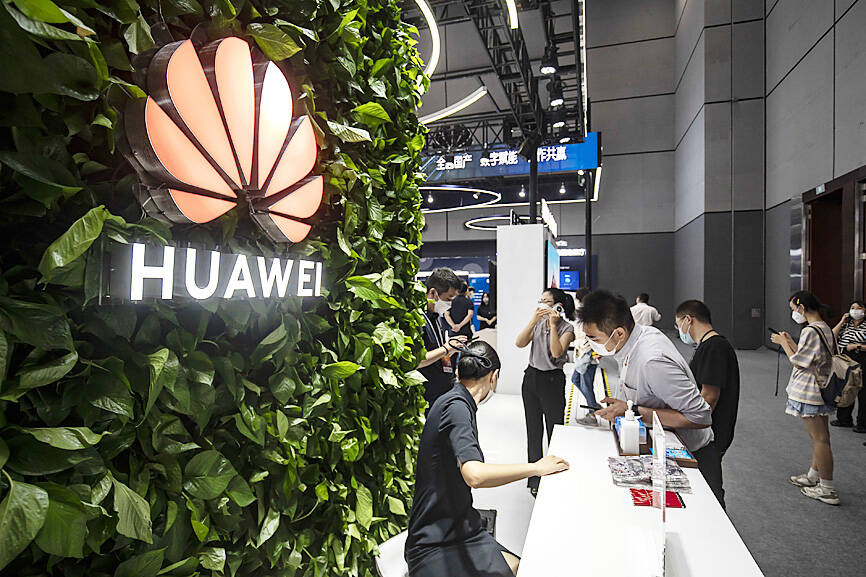Huawei Technologies Co (華為) posted its third straight quarter of growth, declaring a return to normalcy after overcoming a plethora of US restrictions this year.
Huawei’s sales rose 7.2 percent to 191 billion yuan (US$27.47 billion) in the quarter ending this month, after carving out new income streams from areas such as smart vehicles and cloud services, company data showed.
Last year’s sales stood at 636.9 billion yuan, the Shenzhen-based company said, up marginally from a year earlier.

Photo: Bloomberg
Huawei is trying to open up new markets and businesses after US tech export restrictions gutted its smartphone business — briefly the world’s largest — and curtailed the sale of advanced gear in developed markets. Among those trade restrictions is a ban on contract chipmakers producing semiconductors designed by Huawei, crippling its HiSilicon design business.
Huawei rotating chairman Eric Xu (徐直軍) in a new year’s message to employees warned of macroeconomic uncertainty next year.
However, Xu said longer-term demand for technology remains intact. He did not specify how the company might overcome export restrictions, but Huawei has spent much of the past three years developing, researching and sourcing alternatives to US components.
“In 2022, we successfully pulled ourselves out of crisis mode. US restrictions are now our new normal, and we’re back to business as usual,” Xu said.
“The macro environment may be rife with uncertainty, but what we can be certain about is that digitalization and decarbonization are the way forward, and they’re where future opportunities lie,” he added.
Huawei has also sought out alternative sources of income by selling patents, technology services and wireless gear to new customers ranging from automakers to coal mines and industrial parks. It levies royalties from the world’s largest smartphone brands, including Apple Inc and Samsung Electronics Co.
The company has signed more than 20 patent license agreements this year, Huawei global head of IP Alan Fan (樊志勇) said.
“We’ve managed to keep our heads above the water because we fought together,” Xu wrote. “2023 will be the first year that we return to business as usual with external restrictions still in place.”

The number of Taiwanese working in the US rose to a record high of 137,000 last year, driven largely by Taiwan Semiconductor Manufacturing Co’s (TSMC, 台積電) rapid overseas expansion, according to government data released yesterday. A total of 666,000 Taiwanese nationals were employed abroad last year, an increase of 45,000 from 2023 and the highest level since the COVID-19 pandemic, data from the Directorate-General of Budget, Accounting and Statistics (DGBAS) showed. Overseas employment had steadily increased between 2009 and 2019, peaking at 739,000, before plunging to 319,000 in 2021 amid US-China trade tensions, global supply chain shifts, reshoring by Taiwanese companies and

Shiina Ito has had fewer Chinese customers at her Tokyo jewelry shop since Beijing issued a travel warning in the wake of a diplomatic spat, but she said she was not concerned. A souring of Tokyo-Beijing relations this month, following remarks by Japanese Prime Minister Sanae Takaichi about Taiwan, has fueled concerns about the impact on the ritzy boutiques, noodle joints and hotels where holidaymakers spend their cash. However, businesses in Tokyo largely shrugged off any anxiety. “Since there are fewer Chinese customers, it’s become a bit easier for Japanese shoppers to visit, so our sales haven’t really dropped,” Ito

Taiwan Semiconductor Manufacturing Co (TSMC, 台積電) received about NT$147 billion (US$4.71 billion) in subsidies from the US, Japanese, German and Chinese governments over the past two years for its global expansion. Financial data compiled by the world’s largest contract chipmaker showed the company secured NT$4.77 billion in subsidies from the governments in the third quarter, bringing the total for the first three quarters of the year to about NT$71.9 billion. Along with the NT$75.16 billion in financial aid TSMC received last year, the chipmaker obtained NT$147 billion in subsidies in almost two years, the data showed. The subsidies received by its subsidiaries —

OUTLOOK: Pat Gelsinger said he did not expect the heavy AI infrastructure investments by the major cloud service providers to cause an AI bubble to burst soon Building a resilient energy supply chain is crucial for Taiwan to develop artificial intelligence (AI) technology and grow its economy, former Intel Corp chief executive officer Pat Gelsinger said yesterday. Gelsinger, now a general partner at the US venture capital firm Playground Global LLC, was asked at a news conference in Taipei about his views on Taiwan’s hardware development and growing concern over an AI bubble. “Today, the greatest issue in Taiwan isn’t even in the software or in architecture. It is energy,” Gelsinger said. “You are not in the position to have a resilient energy supply chain, and that,